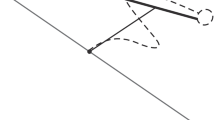Abstract
The aim of this study is to investigate the dynamics of an accelerating skater–board system modeling downhill motion. The governing mathematical model is a system of time-varying neutral delay-differential equations. Stability analysis is performed based on the frozen-time method, and the results are verified via numerical simulations. It is shown that the varying longitudinal speed may result in loss of stability at high speeds, which explains the unpredictable falling often observed at real downhill skateboarding. The positive effect of large longitudinal acceleration on the stability is also demonstrated.






Similar content being viewed by others
References
Hubbard M (1979) Lateral dynamics and stability of the skateboard. J Appl Mech 46:931–936. https://doi.org/10.1115/1.3424680
Hubbard M (1980) Human control of the skateboard. J Biomech 13(9):745–754. https://doi.org/10.1016/0021-9290(80)90236-5
Bloch AM (2003) Nonholonomic mechanics and control. Springer, New York
Stepan G (2009) Delay effects in the human sensory system during balancing. Philos Trans R Soc Lond A Math Phys Eng Sci 367(1891):1195–1212
Insperger T, Milton J (2014) Sensory uncertainty and stick balancing at the fingertip. Biol Cybern 108(1):85–101. https://doi.org/10.1007/s00422-013-0582-2
Chagdes JR, Rietdyk S, Jeffrey MH, Howard NZ, Raman A (2013) Dynamic stability of a human standing on a balance board. J Biomech 46(15):2593–2602. https://doi.org/10.1016/j.jbiomech.2013.08.012
Kremnev AV (2008) Dynamics and simulation of the simplest model of a skateboard. In: Proceedings of Europian nonlinear dynamics conference 2008 (ENOC-2008), 30 June–4 July, 2008, Saint Petersburg, Russia
Varszegi B, Takacs D (2016) Downhill motion of the skater–skateboard system. Period Polytechn Mech Eng 60(1):58–65. https://doi.org/10.3311/PPme.8636
Rosatello M, Dion JL, Renaud F, Garibaldi L (2015) The skateboard speed wobble. In: Proceedings of ASME 11th international conference on multibody systems, nonlinear dynamics, and control, 2–5 Aug 2015, Boston, MA, USA. https://doi.org/10.1115/DETC2015-47326
Varszegi B, Takacs D, Stepan G, Hogan SJ (2016) Stabilizing skateboard speed-wobble with reflex delay. J R Soc Interface 13:20160345. https://doi.org/10.1098/rsif.2016.034
Wisse M, Schwab AL (2005) Skateboards, bicycles, and three-dimensional biped walking machines: velocity-dependent stability by means of lean-to-yaw coupling. Int J Robot Res 24(6):417–429. https://doi.org/10.1177/0278364905053803
Collins S, Ruina A, Tedrake R, Wisse M (2005) Efficient bipedal robots based on passive-dynamic walkers. Science 307(5712):1082–1085. https://doi.org/10.1126/science.1107799
Cossalter V, Lot R, Massaro M (2008) The chatter of racing motorcycles. Veh Syst Dyn 46(4):339–353. https://doi.org/10.1080/00423110701416501
Weiss L, Infante E (1965) On the stability of systems defined over a finite time interval. Proc Nat Acad Sci 54(1):44–48
Moulay E, Perruquetti W (2008) Finite time stability conditions for non-autonomous continuous systems. Int J Control 81(5):797–803. https://doi.org/10.1080/00207170701650303
Peterka RJ (2002) Sensorimotor integration in human postural control. J Neurophysiol 88(3):1097–1118. https://doi.org/10.1152/jn.00605.2001
Kane TR, Levinson DA (2005) Dynamics, theory and applications. Internet-First University Press, Ithaca
Baruh H (1999) Analytical dynamics. WCB/McGraw-Hill, Boston
Insperger T, Stepan G (2011) Semi-discretization for time-delay systems–stability and engineering applications. Springer, New York
Loram ID, Lakie M (2002) Direct measurement of human ankle stiffness during quiet standing: the intrinsic mechanical stiffness is insufficient for stability. J Physiol 545(3):1041–1053. https://doi.org/10.1113/jphysiol.2002.025049
Stepan G (1989) Retarded dynamical systems: stability and characteristic functions. Longman Scientific, London (UK & Technical co-published with Wiley, New York)
Guiness World Records (Online). http://www.guinnessworldrecords.com/. Accessed 18th July 2017
Varszegi B, Takacs D, Stepan G (2017) Stability of damped skateboards under human control. J Comput Nonlinear Dyn 12(5):051014. https://doi.org/10.1115/1.4036482
Author information
Authors and Affiliations
Corresponding author
Rights and permissions
About this article
Cite this article
Varszegi, B., Takacs, D. & Insperger, T. Acceleration helps in skateboarding at high speeds. Int. J. Dynam. Control 6, 982–989 (2018). https://doi.org/10.1007/s40435-017-0368-9
Received:
Revised:
Accepted:
Published:
Issue Date:
DOI: https://doi.org/10.1007/s40435-017-0368-9




